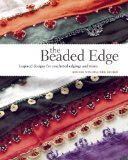I am much more a crocheter than a knitter. I am always saddened by the wacky and weird things that people crochet, even today. I sometimes think we haven't quite gotten over the horrors of 70s crochet. I suspect one of the issues is that many people want instant gratification. The result is a preponderance of chunky yarns giving rise to bulky sweaters and unwearable socks. But have you noticed we rarely say these items are lovely, elegant, or beautiful?
Back in the hey-day of the needle arts, women made some stunning things. Most of these were created with very fine yarns (and threads) and tiny hooks and needles. These laces, stockings, and baby garments are universally appealing, even today. Sadly, few people devote time to try to master the skills. It's not difficult - it just takes time.
I have a deep seated love of crochet lace and I do make some now and again. Usually it is for a figure, and because they are small in scale, I must use threads and tiny hooks. The results are always amazing. It is worth every minute and finger cramp.
I have an extensive library of vintage patterns and books, but my heart always goes pitter patter when I find something new. The Beaded Edge: Inspired Designs For Crocheted Edgings and Trims by Midori Nishida covers a topic new to me: Turkish oya. These are simple edgings created primarily with chain stitches and beads pre-strung on the thread. The result is a lacy, but sturdy, beaded edging that is then stitched onto the fabric. The projects are simple, but give examples of how the edgings could be used for just about anything. The front half of the book provides clear, large photos of the edgings in process. The second half provides universal diagrams to clearly show all the steps for each edging. If you are familiar with Japanese crochet books, you know how well these diagrams can be done; this book is an excellent example. In the middle is a brief discussion about how the author discovered oya, their history and use. The format is a bit odd, as the text is rather dense and jam-packed into three pages. It seemed almost an afterthought to toss it in and doesn't match the rest of the book stylistically.
No matter, this is a great book. I have only one negative comment, and it is minor. There is a photo on page 55 showing vintage oya, and most of the designs are not provided. Dang! There is a second book, however, so I have hope I can find some of the patterns there. I recommend this book to all crocheters - nearly everyone will find something useful and the techniques are easy enough for beginners.


No comments:
Post a Comment